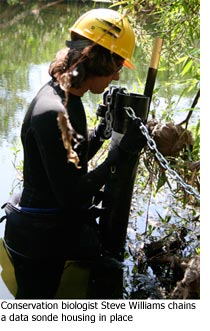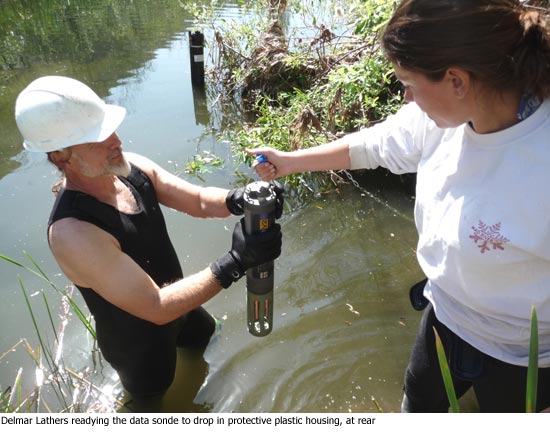New summer jobs for low-income youth
April 6, 2010
The Board of Supervisors on Tuesday voted to expand the county’s longstanding summer jobs program for young people, tapping federal stimulus dollars to create new opportunities for youths in a variety of low-income settings.
With the board’s action, county officials in the Departments of Public Social Services and Community and Senior Services will gain access to $11.7 million in new American Recovery and Reinvestment Act monies. That infusion is expected to boost the county’s Summer Youth Employment Program by as many as 15,000 new jobs.
The expansion—proposed in a motion by Supervisors Don Knabe and Zev Yaroslavsky—will target foster youth in low-income households, young adults aging out of the foster-care system, teens in CalWORKS households, teens on food stamps and emancipated foster youth aged 18-24 who are living in qualifying low-income households.
The summer jobs program is administered through the county’s Workforce Investment Boards, which are funded by the federal government. Information on WIB youth programs can be found here. And click here for a tentative list of ARRA summer youth employers in Los Angeles County.
4/6/2010
What’s killing Malibu Creek’s steelhead
April 6, 2010
Twice in recent summers, Malibu Creek’s fledging population of endangered steelhead have been decimated, leaving the experts baffled and saddened.
In 2006, hundreds of the fish turned yellow and died after a heat wave that was accompanied by a foul-smelling black layer of rotting algae and bacteria in the stream bed. The ooze earned a nickname: Malibu Muck.
By early 2008, the population of juvenile steelhead managed to edge toward 3,000 again, giving biologists hope that the fish were making a strong comeback.
But last year, the die-offs returned with a vengeance. Steelhead, as well as the hardy carp, crayfish and others, died en masse. The Malibu Muck was back, too. This time, the baby steelhead didn’t turn yellow but the population in the creek still plummeted from about 1,300 to just 200 young fish.
In the bad years, “everything was dying,” says conservation biologist Rosi Dagit. “And we really had absolutely no clue why.”
Last week, Dagit and other conservation biologists waded into the creek to look for answers, launching the most comprehensive water quality study ever undertaken in the crucial Santa Monica Mountains watershed.
 Standing waist deep in Malibu Creek, Steve Williams and Kevin Jonz carefully slid a high-tech measuring device called a sonde inside a plastic housing and dipped it into the algae-green water. They anchored the two-foot cylinder to the creek bed with a steel fence post and then fastened the contraption to a willow thicket with a stout metal chain.
Standing waist deep in Malibu Creek, Steve Williams and Kevin Jonz carefully slid a high-tech measuring device called a sonde inside a plastic housing and dipped it into the algae-green water. They anchored the two-foot cylinder to the creek bed with a steel fence post and then fastened the contraption to a willow thicket with a stout metal chain.
In all, five sondes were installed—four in Malibu Creek and one in nearby Topanga Creek. The devices will gather six vital measures of water quality every 30 minutes, around the clock, from April to October. The thousands of data points on water temperature, clarity, pH, algae levels, conductivity and oxygen levels will provide scientists with a full view of the changes in water quality over an entire season, from the high flows of spring to the slack low water of late summer and fall.
“The overarching question is what [water quality] factors are causing problems for the steelhead recovery,” says Dagit, a senior conservation biologist for the Resource Conservation District of the Santa Monica Mountains and the study’s lead scientist. “If you can find ways to give the fish a chance, then you can grow the population.”
Southern steelhead are sea-going rainbow trout that, like their salmon cousins, return to spawn in the creeks and rivers of their birth. The red-stripped, olive-and-silver fish, which can grow to 35 inches or more, has been in decline since the 1950s and became endangered more than a decade ago.
Thousands of tiny steelhead are born in creeks from San Luis Obispo to Mexico, but few survive to migrate to the Pacific. Today, the total population of adult fish that made it into the ocean off Southern California is estimated at only 500. (A northern subspecies, also endangered, ranges from Central California to Canada.)
If the southern steelhead are to stage a comeback, they’ll need to breed in the deep pools of streams like Malibu Creek, where the young must survive for a couple of years until they’re old enough to head to sea.
Dagit and others believe that the Malibu Muck is at least partially responsible for the carnage. They hope the new study will provide clues to why the muck can be so bad in some years and not in others. At its worst, it’s a carpet of black and white ooze a foot deep in places, coating the entire creek bed. Composed of rotting algae, bacteria and smelling like sulfur, the muck was “ubiquitous” at the time of the die-offs, Dagit says.
 Whatever connects the muck to the fish kills, it’s not as simple as the presence of a simple toxin in the water. An earlier chemical analysis of a muck sample turned up nothing that would account for the deaths, says conservation biologist Sandra Albers.
Whatever connects the muck to the fish kills, it’s not as simple as the presence of a simple toxin in the water. An earlier chemical analysis of a muck sample turned up nothing that would account for the deaths, says conservation biologist Sandra Albers.
Today, steelhead can only travel two miles upstream, where a dam built in the 1920s blocks their path. So the scientists placed two sondes in the steelhead pools in the lowest parts of the creek. Two more will be placed in similar deep pools above the dam to see if conditions in the lower creek are significantly different. The sonde in Topanga Creek—a stream that also supports a small steelhead population—was placed there as a way to compare its healthier waters with those of Malibu Creek.
Albers and others will download the data every month via handheld devices that plug into the sondes, four of which are on loan from the Southern California Coastal Water Research Project and the other from the Las Virgenes Water District. Supervisor Zev Yaroslavsky’s office has committed $8,000 to help cover the project’s costs.
No one is expecting a simple fix. But the hope is that scientists can develop a new hypothesis by combining the data with ongoing studies of steelhead counts, algae populations and the proliferation of a tiny invasive pest called the New Zealand mud snail.
Still, the scientists believe they’ll find useful information that will someday allow steelhead to grow up in Malibu Creek once again in significant numbers.
“There are a couple of pieces of the puzzle that we don’t have a handle on,” says fish biologist Carl Demetropoulos, an environmental consultant who volunteers his time to help with the study and fondly remembers catching small steelhead with his dad in Malibu and Topanga in the mid-1960s. “Steelhead are really adaptable and the best hope is that they are already able to come back.”
Posted 4/6/10
Students take the poll position
April 6, 2010
 Who says democracy is only for the 18-and-older crowd? And who says teenagers are a cynical bunch?
Who says democracy is only for the 18-and-older crowd? And who says teenagers are a cynical bunch?
More than 2,500 Los Angeles County teenagers are expected to dip their toes into the waters of political awareness on June 8 by volunteering at polling places for the California primary elections. The county’s popular Student Poll Worker Program is open to public and private school students who are at least 16, are U.S. citizens, have a minimum grade point average of 2.5 and have parental and teacher consent.
But wait, there’s more.
Student volunteers will receive a stipend of up to $105 after completing a two-hour training session and their election-day duties. The stipend can also be exchanged for school community service credit. According to teacher coordinators, the money is well spent.
“When I tell them they can earn $100, that’s a lot of money,” says Stan Bartosiak, a social studies teacher at Glendale High School who has been a local coordinator for the program for the past four years.
“But once they’ve done it, it’s such an overwhelming civic experience. Their perceptions change, no doubt about it. They get to work as adults in a situation that’s rarely available to them,” Bartosiak says, adding: “If we can get life-long voters, 100 bucks per kid is a great investment,”
Bartosiak, who has taught at Glendale High for two decades, is so committed to making sure his students become voters that he holds 18th birthday celebrations for them in class and registers them to vote on the spot.
Blanca Casarrubias, countywide outreach manager for Student Poll Worker Program, said she had 37,500 total student volunteers in the November, 2008, elections and expects more than 3,000 in November, 2010. Students are placed in polling sites within their neighborhoods and work from 6:00 a.m. until approximately 9:30 p.m.
Casarrubias says there are unique benefits for bringing students on board. Many, she said, are bilingual, technologically savvy and sometimes more dependable than adults because they have made the commitment through teachers and parents. And, Casarrubias noted, they can carry heavy election supplies.
Registration must be completed via the school’s designated teacher coordinator and be completed by April 9. Details about registration are available here.
Posted 4/06/10
A plan to help homeowners go green and save green
April 1, 2010
 Property owners in Los Angeles will find it easier and more affordable to “go green” with energy-efficient and water-saving equipment installations under a new program considered for adoption this week by the Board of Supervisors.
Property owners in Los Angeles will find it easier and more affordable to “go green” with energy-efficient and water-saving equipment installations under a new program considered for adoption this week by the Board of Supervisors.
Thanks to AB 811, a state law enacted in 2008, local governments may establish programs that allow property owners to finance renewable energy and resource-efficiency retrofits through voluntary assessments on their property tax bills. Unlike similar previous efforts to spur renewable-energy investments, however, this innovative strategy removes two key barriers that hampered earlier programs.
By allowing property owners to take out energy-efficiency loans and pay them back over time, the program does away with property owners’ significant up-front personal investment. At the same time, it removes their back-end liability for costly improvements that have yet to pay off in energy savings because after a property is sold, the loan stays with the new buyer, not with the previous owner. Because the new owners will continue reaping the benefits of the energy efficient installations, they will fairly assume the existing loan obligation.
County officials estimate that during the program’s first two years, some 15,000 homes could be retrofitted, pumping $150 million into the local economy and creating as many as 2,600 green-related jobs. And the environment would benefit, too: all those energy-efficient and water-saving systems could help the state and County reduce greenhouse gas emissions by 20,000 tons of carbon dioxide annually.
Posted 4/1/10
A show of wings at L.A. museum
April 1, 2010
The California Dogface is getting ready for its close up. So are the Mourning Cloaks, Giant Swallowtails and Red Admirals.
A cast of hundreds of moths and butterflies are about to alight, oh so delicately, at L.A. County’s Natural History Museum when the annual Pavilion of Wings opens April 11. More than 40 different species will star in the 5-month show, held in a giant tent on the museum’s south lawn.
Last year’s exhibition attracted more than 65,000 visitors during its run. Tickets cost $3 for adults, $2 for seniors and students and $1 for children ages 5-12. Visitors under 5 are admitted for free.
For organizers, there’s no winging this kind of show, says museum entomologist Brent “the Bug Guy” Karner, the exhibit’s impresario for the past 10 years. He says it takes months of intricate planning, including a lot of overnight shipments and preparation for the show’s final act—the appearance of hundreds of ravenous spiders.
Logistics for this one started in January, when Karner and his crew of naturalists placed orders from “butterfly farms” in Texas, Florida and California. The farms attract butterflies and moths by planting flowers, shrubs and trees on which the various species lay eggs. Farmers then nurse them through the early stages of life: egg, caterpillar and chrysalis, which is the immobile, hard-coated pupa stage before adulthood.
 Beginning this week, boxes of chrysalises will begin arriving in overnight deliveries. Karner’s entomologists will carefully place the chrysalises in mesh cages indoors until they metamorphose into adults and are ready to be transferred to the tent, filled with dozens of plants and flowers that attract the flying beauties.
Beginning this week, boxes of chrysalises will begin arriving in overnight deliveries. Karner’s entomologists will carefully place the chrysalises in mesh cages indoors until they metamorphose into adults and are ready to be transferred to the tent, filled with dozens of plants and flowers that attract the flying beauties.
Because moths and butterflies don’t survive long as adults—most die after 3 to 4 weeks—Karner keeps weekly shipments coming throughout the show’s run, ending in September.
To ensure a big opening day crowd, he also orders shipments of live adults, which are sealed in envelopes packed inside boxes. “So long as you send them overnight,” Karner says, “they’ll all be fine on our end.”
All of the species are from the U.S., with about half native to California. The California dogface, so called because of a white mark on its wings that looks like a canine’s mug, is the official state insect. Among this year’s newbies is the Small Postman, a tropical pollen-eating butterfly from south Texas. Karner says he’s also increased the quotient of moths, which he believes deserve equal billing. “Butterflies are just day-flying moths,” Karner sniffs. They include Hawk moths, who hover and dart like birds of prey.
Karner and the museum staff use the moths and butterflies to teach about insect evolution and to explore the relationships between insects and the plants they eat as caterpillars and use as breeding grounds. “Those lessons make the experience at our butterfly pavilion much deeper than most others,” he says. “It’s pretty darned cool.”
Come September, one last drama of nature will unfold in the tent and out of public view as the fall spider show prepares to move in. The winged stars quickly become arachnid lunch. “The spiders take care of all my butterflies,” says Karner. “Unfortunately, people don’t get to see the massive onslaught.”
Maybe that’s just as well.
Posted 4-01-10
Meet up to plan the subway
March 31, 2010
Want to have a say in what your subway will look like and where it will go?
As planners prepare to extend the subway westward, Metro is headed back to the Westside for a new series of community meetings this spring.
The meetings, which begin April 12, will feature updates on station planning, locations and design. Metro’s last round of community meetings in the fall of 2009 regularly attracted hundreds of people.
This time around, Metro officials will provide preliminary information on the five alternative routes for the extension currently under review. These proposed routes would add branches and stations at varying points throughout the Westside, including stations at Wilshire/Crenshaw and in the Westwood/UCLA area.
Information and community input from the meetings will be considered before Metro releases a Draft Environmental Impact Statement/Environmental Impact Report (Draft EIS/EIR) this coming summer. Technical analysis and development plans in the Draft EIS/EIR will be made available for public review before construction begins on the project.
Meeting schedules and summaries of past meetings are available here.
Posted 3/31/10
Veggie smugglers, beware
March 31, 2010
In L.A. County’s canine workforce, you’ve got your glamour hounds– dogs who can sniff out a multimillion dollar drug cache faster than you can say “film at 11.” And you’ve got your rough-and-ready patrol dogs—the ones renowned for collaring runaway bad guys in mean back alleys.
But where, oh where is that rare breed of dog who can take down a rogue shipment of dandelion greens, bok choy and parsley? To which the county agriculture department says: Meet Ebony and Tahoe.
The new dogs on the beat, together with their handlers, inspectors Hung Truong and Rogelio Carranza, are the pioneering members of the county’s new Agricultural Detector Dog Program.
Truong and Carranza recently traveled to Georgia for a 10-week course at the USDA National Detector Dog Training Center. There, they met their new dog partners and got to work on illicit produce detection.
The training initially involved teaching dogs to scratch at boxes in which handlers had placed five different fruits—guava, mangoes, stone fruit, oranges and apples. Then “non-target boxes”—containing items like clothes, candy and shampoo—were added to the mix, with treats bestowed on the dogs when they continued to scratch at the fruit-filled boxes in the midst of the other packages.
Since February, the team has been on the job in Los Angeles County, conducting inspections at FedEx warehouses and planning to expand soon into UPS and U.S. Postal Service facilities as well.
The stakes are high. An unwelcome pest that hitches a ride on, say, some homegrown peaches could quickly become established here.
“An infestation of such pests could cost California millions of dollars in crop and job losses, increased pesticide use, and quarantines that impact trade,” according to a new brochure on the program.
“The granddaddy of all pests that we don’t want to have infesting this county are the fruit flies,” says Dave Cassidy, quarantine deputy for the Department of Agricultural Commissioner/Director of Weights and Measures. “By stopping it before it even gets here, that’s the cheapest method.”
The effort is being funded with $311,205 in federal money passed along by the California Department of Food and Agriculture—an arrangement approved Tuesday by the Board of Supervisors. The funding covers all expenses associated with the program, including dogs, training and human salaries.
The team already is earning kudos for its work. Ebony, a Lab mix, was prominently featured in a recent pest report put out by the California Department of Food & Agriculture. In the best just-the-facts style of the police blotter, under the headline “LA County’s New Detector Dog Team’s First Find!” it said:
“On March 5, 2010, at about 8:00 a.m. at the FedEx in Santa Fe Springs, Ebony responded to an unmarked box sent from Arizona.
Inspector Truong and supervisor Carmen Rieger opened the unmarked box and found it contained dandelion greens, bok choy, dill, green lettuce, and parsley.”
What sounded like an innocent salad bar became considerably less appetizing when you learned about the garnishes it was carrying.
“The mixed vegetables appeared home grown and contained ants, aphids, mites, slugs, springtails, wasps, and moths. One of the insects was a big-headed ant (Pheidole sp.) which is a Q-rated pest. The shipment’s contents were destroyed by freezing.”
The discovery came as a shock—not least of all to Truong, who thought he was looking at an olive oil shipment.
 As for her compensation for the big find—“We call it ‘Jackpot,’ ” Truong says. “Instead of one piece of treat, we give ‘em four… They’re working for the treat, but they’re also working for us, so we praise ‘em up. I give her belly rubs, too.”
As for her compensation for the big find—“We call it ‘Jackpot,’ ” Truong says. “Instead of one piece of treat, we give ‘em four… They’re working for the treat, but they’re also working for us, so we praise ‘em up. I give her belly rubs, too.”
Tahoe, a purebred Labrador who weighs in at 70 pounds, has been making his share of finds, too, recently detecting an unmarked shipment of leeks coming from Michigan, according to Carranza, his handler.
It’s important work—and something that humans just can’t do. Unless a produce shipment is leaking, smelly, “taped weird,” or “coming from a high-risk area,” human inspectors have to rely on correct labeling to tell them what to inspect, says Rieger, the teams’ supervisor. But with dogs sniffing out the packages—correctly labeled and otherwise—as they come down the conveyor belt, human inspectors can devote more energy to properly investigating what they find.
“I love it,” says Carranza, 49, a 20-year department veteran. “Right now, I think it’s better with my dog. I’m not alone.”
Posted 3/30/10
Foster homes to be investigated
March 30, 2010
 Responding to the brutal death of a two-year-old toddler, Los Angeles County’s child welfare chief on Tuesday promised a broad emergency examination of all foster home agencies under contract with the county, which are responsible for the well being of more than 5,800 children.
Responding to the brutal death of a two-year-old toddler, Los Angeles County’s child welfare chief on Tuesday promised a broad emergency examination of all foster home agencies under contract with the county, which are responsible for the well being of more than 5,800 children.
The goal, said Department of Children and Family Services Director Trish Ploehn, is to swiftly determine that there are “are no children left in danger.” She added: “For the children in foster homes, we are doing a 100 percent review.”
Ploehn, who’s been under fire for a series high-profile child deaths in recent months, told the Board of Supervisors that county social workers will visit 2,500 foster homes with a detailed “physical environment checklist” aimed at determining whether they share the type of unsafe and illegal conditions found in the South Los Angeles home where toddler Viola Vanclief died on March 4. The children themselves, Ploehn said, will be interviewed and asked, among other things, whether they’re being properly fed and how many adults reside in the home.
The review was requested in closed session last week by the supervisors after disclosures of Viola’s death, who, according to a newly released Coroner’s report, suffered blunt force trauma and extensive internal injuries. The homes that will be inspected are part of a network of Foster Family Agencies (FFA), paid by the county and primarily responsible for ensuring the safety of children in homes they oversee, including hiring independent social workers to conduct inspections.
On Tuesday, those 58 agencies were reduced by one.
Acting on a recommendation by Ploehn, the board unanimously voted to terminate the contract of United Care, the foster agency that had placed Viola in one of its 88 homes.
That home was run by Kiana Barker, a licensed foster parent who had been the subject of five earlier neglect or abuse complaints, including one in which it was determined that she’d neglected her own daughter. Barker had an earlier conviction for theft, but had succeeded in obtaining a state license.
She told police investigators that she’d accidentally struck Viola with a hammer while trying to free her from a bed frame in which she’d become tangled. Also living in the house was Barker’s boyfriend, James Julian, a convicted armed robber. Both were arrested on suspicion of murder in Viola’s death and released without charges, pending results of the continuing criminal probe.
Child welfare investigators turned up evidence at Barker’s home of apparent lax supervision by United Care.
The agency failed to notice, for example, that Julian was living there, a violation of state law because of his criminal record. Julian had tried and failed to obtain a license as a foster parent in 2007. He and Barker had a 6 month-old child together.
Appearing before the Board of Supervisors on Tuesday, United Care’s executive director, Craig Woods, said revocation of his contract would be a “premature rush to action” based in part on “grossly inaccurate” media accounts. “United Care has a stellar 21-year track record,” he said, “and this one event should not warrant the termination of our contract.”
Woods said that the social workers hired by his agency twice made surprise visits to the home in February and found no clothing or other evidence that Barker’s boyfriend was living there. Barker had also signed a sworn statement to that effect, United Care’s executive director said.
In an exchange with Supervisor Zev Yaroslavsky, Woods said he was unaware that padlocks had blocked access to some rooms in the home, contrary to foster home rules. Woods also said he did not know that several video cameras were stationed around the home. The purpose and precise location of the cameras were not clear.
Woods also insisted that Barker’s prior theft conviction should not be considered as part of the revocation. Many foster parents, he suggested, have obtained licenses despite non-serious criminal records. In fact, he contended that “as many as half” of foster parents in Los Angeles County have criminal records and were able to get exemptions from the state to get licenses.
But Gary Palmer of the state’s Department of Social Services said Wood’s number is “totally false.” Palmer, chief of the technical assistance and policy branch for community-care licensing, said the exemption figure in Los Angeles County is an average of 5 percent.
Under the emergency review, meanwhile, county social workers and auditors also will take a more comprehensive examination of a randomly-selected sample of about 600 homes that are overseen by Foster Family Agencies. This review will be conducted by social workers from the Department of Children and Family Services and representatives from the County Counsel and Auditor-Controller offices. Also participating will be agents from the state.
Ploehn promised that the investigation would be complete by early May and that she would come back to supervisors with data and recommendations by May 15.
Posted 3/30/10
A key man for a new gang plan [updated]
March 25, 2010
Pacoima is about to see a lot of Greg McCovey.
In this east San Fernando Valley neighborhood, the veteran probation official will soon become the point man for L.A. County’s long-awaited and multi-faceted anti-gang initiative, which the Board of Supervisors is scheduled to review on Tuesday.
Pacoima is one of four gang hotspots that, under the initiative, would be a testing ground for a new approach by the county, placing a much heavier emphasis on gang prevention, in addition to suppression. The other areas, spread across the county, are: Harbor Gateway, Monrovia/ Duarte and Florence/Firestone, home to one of the region’s most entrenched gangs, Florencia 13.
The $3-million plan—several years in the making—calls for a collaborative and coordinated effort among multiple county agencies to ensure that services are directed at juveniles who’ve been accused of gang membership and identified as high-risk for re-joining a gang. The services, which are designed to parallel stepped up law enforcement, also would be provided to families of these individuals.
The Chief Executive Office (CEO) is recommending to the board that, in each of the four targeted areas, the initiative would begin by focusing on 25 juvenile probationers whom the county will attempt to steer from the gang life by bolstering mental health, welfare and economic services. Overseeing each of those four areas will be a “site coordinator” directing several “work groups” responsible for specific facets of the strategy, including providing more parks and library services aimed at the larger community.
McCovey is the first—and, so far, the only—site coordinator selected.
A 20-year Probation Department veteran, he’s anxious to get to work. “This is a great opportunity to bring together a broad array of services to help the community and our (gang) families,” McCovey says. “It’s exciting.”
McCovey, 50, has a good resume for understanding and combating gang culture. In his last assignment in the Probation Department, he directed the intake decisions about where to send minors in juvenile halls throughout the county. Before that job, McCovey directed the Probation Department’s post-release programs from juvenile camps, so he’s seen what happens when gang probationers re-enter the community.
For the past year, McCovey has been on loan to the CEO’s office to help refine the county’s gang plan. He spent time exploring all four neighborhoods in the pilot project, meeting with residents and community groups. And within the next few weeks, he’ll begin interviewing the families of Pacoima probationers to determine which 25 juveniles are at high risk for returning to gangs unless they—and their families—get help.
Pacoima is unique among the four areas because it falls entirely within the City of Los Angeles, McCovey says. That will make some aspects of his job easier because the city already has instituted its gang prevention and patrol initiatives, which are serving as models for the county.
McCovey will work closely, for example, with Los Angeles’ Gang Reduction Youth Development program, the city’s own prevention effort, launched in 2007. The city’s Summer Night Lights program of nighttime soccer, basketball and cultural programs already is in place in Pacoima. The county plans to export similar programs to county parks in the other three demonstration areas.
McCovey says his greatest challenge may be to ensure that county agencies involved in the proposed anti-gang initiative can quickly bring their unique assets to the gang problem without duplicating efforts.
“There are a lot of different groups out there doing good work,” McCovey says, “and we don’t want to overlap.”
If the Board of Supervisors gives a green light to the latest phase of the plan, McCovey expects to start full-time early next month. When not on the ground in Pacoima, he’ll be based in the CEO’s office downtown with the other soon-to-be-selected coordinators.
“I’m very aware of the barriers that kids face when they return home,” McCovey says. “What I want to do is break down those barriers to ensure they have every opportunity to succeed.”
Posted 3/25/10
Updated 4/6 /2010:
The Board of Supervisors unanimously approved the latest phase of the county’s long-anticipated gang reduction initiative after it was amended to modify personnel plans and costs. Among other things, the plan establishes pilot programs to better coordinate anti-gang strategies in four key neighborhoods plagued with gang issues.
Most of the changes Tuesday involved the four “site coordinators” of the pilot programs who would oversee the program in their areas and direct the delivery of services by county departments and local gang prevention groups.
Under the original plan, the coordinators potentially could be hired from several county departments playing key roles in the anti-gang initiative. The plan also included $871,000 for departments to “backfill” for individuals selected as site coordinators.
But an amendment introduced by Supervisor Michael Antonovich required that all four site coordinators be selected from the Probation Department because the plan, for now, focuses primarily on gang probationers. Supervisor Don Knabe proposed a second amendment that cut the money needed to back-fill for the coordinators, meaning the Probation Department would essentially have to absorb the costs.
Antonovich’s amendment also restricted the uses of $400,000 in gang prevention funding in county parks to exclude expenditures on field trips, food and prizes and other items with no direct bearing on gang reduction.

















 Check for the latest closure information
Check for the latest closure information








